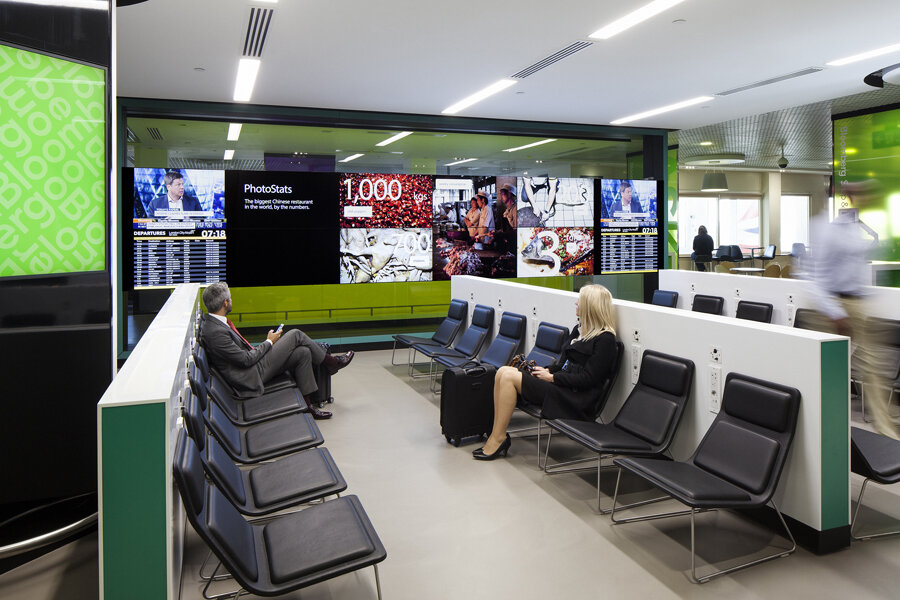Bloomberg Hub at London City Airport makes a visual splash
Loading...
It’s not in London’s largest airport, but the Bloomberg Hub at the London City Airport (LCY) may be a big deal to travelers who no longer have to hunt for a place to plug in or access critical information affecting their flights, thanks to the 23-foot wingspan of an interactive wall that anchors the place.
A friend who recently had a flight from LCY filled me in on the new Bloomberg Hub, which opened in May, and said the fact that the hub allows passengers to recharge both digitally and mentally is both easy to locate and “quite a good idea.”
“The arrival of the Bloomberg Hub in the LCY departure lounge furnishes our passengers with a new level of service – that of up-to-the-minute data and information – which reflects the moves we’re making towards managing the passenger journey through the use of technology,” said Matthew Hall, LCY’s COO in a release.
The LCY has now distinguished itself among my friends who have been there recently as the airport where there’s no squinting across the room at average size flat screens to try and catch the news, weather or other vital travel information.
The media wall is made up of a dozen 55-inch Ultra HD 4K screens, and is 23 ft. long x 10 ft. tall. It’s the first thing a traveler sees from the escalators on the way to customs.
The combined length of the tickers is 426 feet (for scale, Big Ben is only 316 feet tall and the London Eye 443 feet tall). The screens are made of scrolling digital media made up of 23 million light-emitting diodes, or LEDs.
This means weary travelers can look up and see multiple streams of constantly updated headlines and financial information as well as travel-specific information, including world weather and world time, configured according to daily LCY flight destinations.
Steve Blyth, managing director of Engage Productions, London, which supplied the digital display and media wall with audio distribution, as well as all the hardware necessary for technical integration, defended the scope of the project.
“Around 3.4 million passengers travel through London City Airport each year so it’s a buzz to think that so many people will be benefiting from the displays we’ve provided,” Blyth wrote in an email.
While other companies have now engaged Engage to bring lounges to different countries, including the United States, those hubs will not appear until 2015.
Sure, it’s not a major US airport or even Heathrow, through which most people I know travel, but the Bloomberg Hub at London City Airport is a glimpse at travel innovation yet to come.
The concept of a media lounge isn’t new. Many airports have installed little pocket plug-in lounges.
The ones I have experienced are forever overcrowded, leaving many travelers sitting on the floor of an airport beside an outlet as they struggle to connect to some foreign WiFi system.
Perhaps the guys at Bloomberg met with one too many rumpled colleagues, heard enough excuses about not being able to catch the news or stock tickers and decided to engage Engage to make the hub happen.
Engage has recently become known for its FLUX Innovation Lounge technology incubator in London which is packed with a rotating assortment of new tech.
Things that have been integrated into the main Engage FLUX lounge incubator and which could potentially pop up in future hubs created for clients by Engage:
- The Holo, 3D holographic images on a 2.4-meter, 360° 'floating' display which can be controlled by hand gestures.
- Use of EEG and neurofeedback headsets to the Zen Lamp that changes colors with your thought levels.
- Virtual books using Realtime vision and Gesture technology to turn pages, much like a giant Kindle or tablet only on a pedestal with a screen shaped to mimic a massive book.
- Oculus Rift goggles that let visitors become virtual divers descending into the depths of the ocean where they can unwind by interacting with various sea creatures.
- The game "Firecube" from the German company SMART uses Kinnect technology to eliminate traditional controllers and makes your bare hands, the controller for a "Soda" game in which you blast bubbles with a wave or push of your hands alone.
Almost makes you look forward to getting stranded in an airport. Almost.








